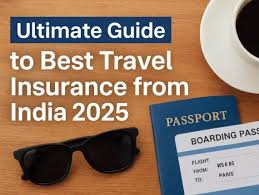Ultimate Guide to Travel Insurance: Travel insurance has become an essential part of trip planning for millions of adventurers, families, and business travelers worldwide. Whether you’re backpacking through Europe, cruising the Caribbean, or embarking on a domestic road trip, unexpected events can turn your dream vacation into a nightmare.
In this comprehensive guide, we’ll explore what travel insurance is, why it’s crucial, and how to find the best coverage for your needs. With rising global uncertainties like health issues, natural disasters, and flight disruptions, understanding travel insurance can save you time, money, and stress.
As of 2025, the travel insurance market continues to evolve, offering more flexible plans tailored to modern travelers. This article breaks down the essentials in an easy-to-read format, optimized for anyone searching for “travel insurance guide,” “best travel insurance plans,” or “how to buy travel insurance.” Let’s dive in.
What Is Travel Insurance?
Travel insurance is a specialized policy designed to protect you financially from unforeseen events during your trip. It acts as a safety net, covering everything from medical emergencies to lost luggage. Unlike standard health or auto insurance, travel policies are trip-specific and often include unique benefits like emergency evacuation.
At its core, travel insurance reimburses you for non-refundable expenses if your plans go awry. For instance, if a sudden illness forces you to cancel your flight, your policy might cover the cost of tickets and hotel bookings. Providers like Allianz and Travel Guard offer plans starting as low as $27 for basic coverage. This makes it accessible for budget-conscious travelers.
Key components of travel insurance include:
- Trip Cancellation/Interruption: Refunds for prepaid expenses if you can’t travel or must cut your trip short.
- Medical Coverage: Pays for healthcare abroad, where your regular insurance might not apply.
- Baggage Protection: Compensates for lost, stolen, or delayed luggage.
- Travel Assistance: 24/7 support for emergencies, like finding a doctor or arranging transport.
Understanding these basics helps when comparing “travel insurance quotes” online.
Why Do You Need Travel Insurance?
Many travelers skip insurance, thinking “it won’t happen to me.” But statistics show otherwise. In 2024 alone, global flight delays affected over 20% of passengers, and medical emergencies abroad cost Americans an average of $25,000 without coverage. Travel insurance isn’t just for international trips—it’s valuable for domestic travel too, especially with rising costs from weather events or personal issues.
Here are top reasons to buy travel insurance:
- Health Risks: Overseas medical bills can bankrupt you. Policies cover hospital stays, doctor visits, and even COVID-19-related issues in 2025.
- Trip Disruptions: Hurricanes, strikes, or family emergencies can cancel plans. Insurance ensures you get your money back.
- Peace of Mind: Knowing you’re protected allows you to enjoy your trip fully.
- Required for Some Destinations: Countries like those in the Schengen Area mandate insurance for visas.
If you’re searching for “why buy travel insurance,” consider this: The U.S. State Department recommends it for all international travel to handle evacuations and accidents. Don’t leave home without it.
Types of Travel Insurance Plans
Not all travel insurance is created equal. Providers offer various plans to suit different needs, from short weekend getaways to long-term expat adventures. Choosing the right type depends on your trip’s duration, destination, and activities.
Common types include:
- Single-Trip Insurance: Ideal for one-off vacations. Covers a specific journey, often the most affordable option.
- Annual/Multi-Trip Insurance: Great for frequent travelers. Provides coverage for multiple trips within a year, saving money in the long run.
- Comprehensive Plans: All-in-one coverage for cancellation, medical, and more. Popular for international travel.
- Medical-Only Plans: Focuses on health emergencies, perfect if you already have trip protection through credit cards.
- Specialty Plans: For cruises, adventure sports, or students studying abroad.
For example, if you’re planning a ski trip, look for policies covering “adventure travel insurance” to include high-risk activities like snowboarding.
What Does Travel Insurance Cover?
Travel insurance policies vary, but most standard plans include a core set of protections. Always read the fine print to understand limits and deductibles.
Typical coverages:
- Emergency Medical Expenses: Up to $1 million for treatments, surgeries, or dental care abroad.
- Trip Cancellation: Reimburses up to 100% of costs for covered reasons like illness, death in the family, or job loss.
- Baggage and Personal Effects: $500–$3,000 for lost items, with daily allowances for delays.
- Travel Delay: Covers extra hotel stays or meals if your flight is postponed.
- Emergency Evacuation: Airlifts you to safety in case of political unrest or natural disasters, often up to $500,000.
- 24/7 Assistance: Hotline for translation, legal help, or replacing lost passports.
In 2025, many plans now include “cancel for any reason” (CFAR) add-ons, allowing flexibility for personal changes. This is especially useful amid ongoing global events.
What Travel Insurance Doesn’t Cover
While travel insurance is comprehensive, it has exclusions. Knowing these prevents unpleasant surprises when filing claims.
Common exclusions:
- Pre-Existing Conditions: Many policies won’t cover health issues diagnosed before purchase, though waivers are available if bought early.
- High-Risk Activities: Base jumping or professional sports often require add-ons.
- Intentional Acts: Damage from illegal activities or self-harm isn’t covered.
- Pandemics (Sometimes): Check for epidemic clauses; some plans exclude widespread outbreaks.
- War or Terrorism: Coverage may be limited in conflict zones.
- Normal Wear and Tear: Everyday issues like forgetting items aren’t reimbursed.
For “travel insurance exclusions,” always compare policies on sites like InsureMyTrip or Squaremouth.
How to Choose the Best Travel Insurance
Selecting the right policy involves assessing your needs and comparing options. Start by evaluating your trip’s value—insurance typically costs 4–10% of total expenses.
Steps to choose:
- Assess Risks: Consider destination risks, like health in remote areas or weather in hurricane-prone spots.
- Compare Quotes: Use aggregators to get “travel insurance quotes” from multiple providers.
- Check Coverage Limits: Ensure medical coverage is at least $100,000 for international trips.
- Read Reviews: Look for customer satisfaction on claims processing.
- Buy Early: Purchase within 14–21 days of booking for pre-existing condition waivers.
Tools like comparison sites help filter by “best travel insurance for seniors” or “cheap travel insurance.”
Top Travel Insurance Companies in 2025
Based on expert reviews, here are some leading providers:
- Allianz Global Assistance: Known for affordable plans and a vast hospital network.
- Travel Guard: Offers customizable plans with strong medical coverage.
- InsureMyTrip: Compares 20+ companies, ideal for comprehensive options.
- Travelers Insurance: Great for bundling with auto or home policies.
- Faye Travel Insurance: Stands out for instant claims and app-based support.
According to U.S. News, top-rated companies excel in trip interruption and baggage delay coverage. For “best travel insurance companies,” these consistently rank high.
| Company | Best For | Starting Price |
|---|---|---|
| Allianz | Budget Travelers | $27 |
| Travel Guard | Families | Varies |
| Faye | Tech-Savvy Users | Custom |
| VisitorsCoverage | International Visitors | Affordable |
How Much Does Travel Insurance Cost?
Costs depend on factors like age, trip length, destination, and coverage level. A basic plan for a $5,000 week-long trip might cost $200–$500.
Breakdown:
- Age: Older travelers pay more due to health risks.
- Trip Cost: Higher-value trips increase premiums.
- Add-Ons: CFAR or adventure coverage adds 40–50%.
- Destination: Riskier areas like war zones cost extra.
Shop around for “affordable travel insurance” to find deals. Annual plans can save frequent flyers up to 50%.
Tips for Buying Travel Insurance
To maximize value:
- Buy from Third Parties: Avoid airline-offered insurance; independent providers offer better terms.
- Use Credit Cards Wisely: Some cards provide built-in coverage, but check limits.
- Document Everything: Keep receipts for smooth claims.
- Consider Group Policies: Families or groups get discounts.
- Review Annually: Update for new travel patterns.
For “travel insurance tips,” prioritize policies with 24/7 support.
Common Mistakes to Avoid with Travel Insurance
Avoid these pitfalls:
- Waiting Too Long: Buy soon after booking to cover pre-trip issues.
- Underinsuring: Skimp on medical coverage for costly destinations.
- Ignoring Fine Print: Miss exclusions and regret it later.
- Assuming Coverage: Home insurance rarely extends abroad.
- Not Comparing: Stick with the first quote and overpay.
Learning from “travel insurance mistakes” can prevent headaches.
Conclusion: Secure Your Next Adventure with Travel Insurance
Travel insurance is more than an expense—it’s an investment in worry-free exploration. In 2025, with tools like apps for instant claims and expanded coverages, there’s no excuse to travel unprotected. Whether you’re a solo nomad or family vacationer, finding the right plan ensures you focus on memories, not mishaps.
Ready to get covered? Compare “travel insurance quotes” today and embark on your journey with confidence. Safe travels!



